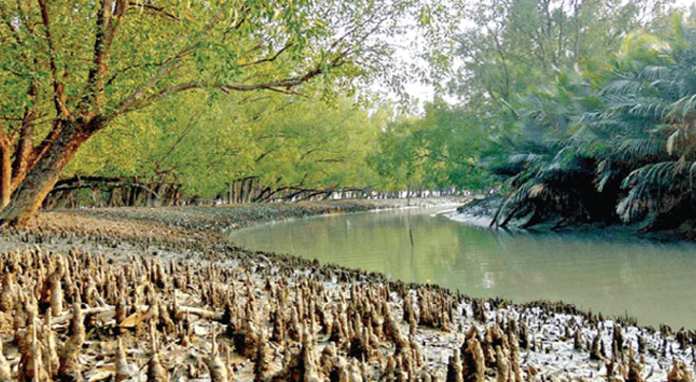
Mangrove trees in the Sundarbans have weakened
Researchers say the health decline of mangrove trees could critically hamper the Sundarbans’ ability to raise back, making it vulnerable to climate-related extreme weather events.
Highlights:
- Increased salinity of the water hampered the health of mangrove trees of the Sundarbans over the past 30 years. However, the number of trees did not decrease during the period.
- The study used the Continuous Change Detection and Classification (CCDC) method to the Landsat data. They were more willing to find changes on the earth surface using satellite data to find the specific area changes from being occupied by mangroves to bare soil or water.
- This method is considered for worldwide application to mangrove monitoring, they claimed.
Sundari tree, the most common mangrove species in the Sundarbans, is becoming unhealthy gradually.
However, there is no significant decline in the number of mangroves in the Sundarbans for the last 30 years. However, there is evidence of a 25% health decline of the mangrove trees.
And, it is due to the effect of increased salinity on Sundari tree. But the continuing climate change could critically hamper its ability to reborn.
About this Study.
A satellite-based data-driven study on world’s mangrove system brought new findings. It says that the effects of climate change could severely hamper the growths of Sundari tree.
Most significantly, the ‘top-dying disease’ is the cause for declining 15% of trees in the Sundarbans since the 80s.
Around 1.44 million cubic meters of Sundari trees have been lost to “top-dying disease in the last 30 years,” experts said.
Top-dying disease among the Sundari, heart-rot disease among the Pashur, and die-back disease in the Kewara, are behind the trees’ rapid decline.
Unfavourably, the Sundari tree is less tolerant of high salinity levels than other mangrove species and has previously identified as suffering from die-back due to rising salinity.
Meanwhile, this recent study did not find any noteworthy decrease in the number of mangroves in Sundarbans last 30 years.
“However, there is evidence of a decline in the health of about 25% of the mangrove trees,” said study author Katie Awty-Carroll of Department of Geography and Earth Sciences, Aberystwyth University, Wales.
Awty-Carroll and his team observed a long 30-year time series of Landsat data of the entire Sundarbans.
However, it is hard to know the proper explanations behind this decline in mangrove health, the scientists think the long-term decrease in mangrove health may be the impact of increased salinity on the Sundari tree.
Accordingly, the analysis shows if 25% of the forest is getting less healthy, those areas will be at greater risk of decline in the future, especially if extreme events such as cyclones become more common,” Awty-Carroll said.
Also, rising sea levels are increasing salinity, severe cyclones mean that the defensive capacity of the Sundarbans could be reduced in future years.
This study also explored the damage of Sidr, which made landfall in Bangladesh in November 2007.
“We estimate that around 11% of the Sundarbans forest was likely to damage by Sidr, which is lower than other estimates,” said Awty-Carroll.
Moreover, they claimed that this study is the only one which looks at damage over the whole of the Sundarbans region immediately after the cyclone’s landfall.
Meanwhile, this study also revealed that the effects of Sidr were still apparent more than ten years after the cyclone made landfall.
Accordingly, this suggests that cyclones could decrease the health of the mangroves for a long.
However, the main limitation of the study is the absence of on-the-ground measurements to compare the satellite observations. Despite having sufficient data, we have to be cautious in interpreting our results.
Andy Large, a field-based physical geographer with Newcastle University, echoed with this report.
We also know, Climate change has to lead to an increase in the salinity of the water and soil of the Sundarbans— which is another reason for the rapid decline in the number of Mangrove Spices.
Earlier, noted water expert Ainun Nishat said, “Sundari trees have been dying due to the adverse effects of the Farakka and a lack of sweet water.”
Earlier, it was a finding of 30ppm of salinity in the water, declines the disease-prevention capacity of the trees.
Read More: